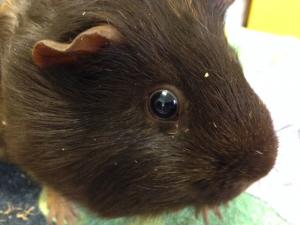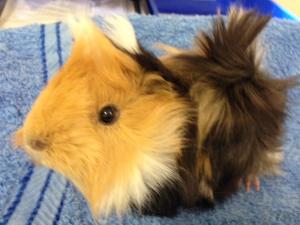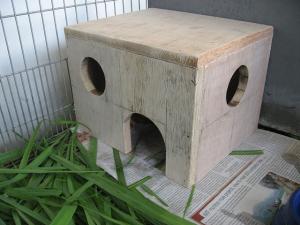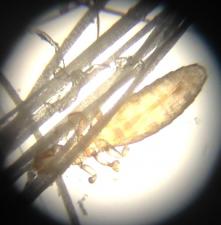
Guinea Pigs or Cavies are excellent for people wanting fun and cute small pets in limited space. They are inquisitive, active, and clean and can be very affectionate if socialised properly. In addition, their diseases are easily prevented or treated by following some simple tips.
However, caring for guinea pigs properly isn’t easy. In addition to specific housing they have quite complex and important food requirements.
Socialisation & Handling

To have a happy, social pet like Haru, get them as soon as they can be independent (around 6 weeks) and gently handle them several times a day in a fun, positive way.
Children need to be supervised as it is very easy to accidentally harm such a small, fragile animal. We see broken legs very commonly from falls from children’s arms so doing this sitting down is advised.
Guinea pigs are social, and probably not very happy on their own. We advise getting two or more of the same sex at the same age when young. Introducing adults can lead to fighting, and using a rabbit as a companion often leads to bullying as well as disease. Male & female cavies are hard to tell apart so your vet can accurately sex them for you to avoid unplanned breeding.
Housing
A secure hutch allowing at least 0.5m2 per cavy should be provided and kept inside the house. Guinea pigs housed outside are extremely vulnerable to heat stroke, or predation by cats and foxes.
Guinea pigs should be allowed out of the hutch every day to play and socialise under adult supervision. Watch out for crevices behind furniture or appliances, and chewing electrical cords.

The most important aspect of a good hutch is the flooring. Harsh, rough or wire floors cause a condition called bumblefoot (ulcerative pododermatitis). In addition to smooth floors, soft bedding should be added, usually in the form of soft grass hay, changed at least every second day. This can be the same hay mentioned later under Feeding. Under this should be an absorbent material to collect urine. Do not use straw or wood shavings as these get easily lodged in eyes and feet.
Water is best provided in the form of sipper bottles. Make sure these are running by jiggling the ball valve at the end as guinea pigs can foul them with food particles.
Hutches should also have areas where guinea pigs can hide, such as a den or tubing. You can buy an amazing range of special houses, tubes, pouches and toys to make their home more secure and interesting.
Feeding Guinea Pigs
Guinea Pigs share the same digestive and dental arrangement as rabbits, and so they have almost identical feeding requirements. If you follow the guide at Feeding Rabbits you will do well. Continuously growing teeth and caecal fermentation require an extremely high level of fibre in the diet to function well.
Meadow or grass hay should be provided at all times and other foods limited to encourage its consumption. Make or buy a wire hopper to hold the hay on the side of the hutch and use it as bedding as well (changed when soiled).
Vetafarm make a high quality Guinea Pig pellet, but these should still only comprise 10-20% of the diet. Mix-type diets are completely inappropriate as they contain excessive amounts of sugars and simple carbohydrates which disrupt the complex fermentation process of cavy digestion.
Health
As prey species, guinea pigs are adept at hiding signs of illness and stress. It is up to the owner of such animals to be particularly aware of their health so you can get to your guinea pig vet in time. We advise weekly weigh-ins using kitchen scales
Unplanned pregnancies are a common problem due to poor knowledge of the difference between males and females by some sellers. It’s risky for a female guinea pig to have her first litter after 7 months of age due to the fusion of the pelvic bones. Vasectomising males is possible to manage the risk of pregnancy in mixed groups, however it’s also acceptable to put up a mesh divider so pigs can communicate without physical contact.
Most guinea pigs need their nails trimmed from time to time. Your vet can show you how to do it at home. We have already mentioned trauma from falls, and bumblefoot as two important husbandry diseases.
‘Slobbers‘ is the folk name for the drooling which accompanies severe dental disease. This is usually as a result of providing little or no hay to keep the teeth worn down.
Gastrointestinal Stasis (the link refers to GI stasis in rabbits but it’s the same for cavies) is caused by low fibre diets causing sludging and impaction of bowel contents. It is usually fatal if not treated quickly
Severe dental problems, swollen joints or general sickness can also be due to Vitamin C deficiency. We only see this in cavies fed exclusively on dry pellet or mix-type diets, even those claiming added Vitamin C. Providing fresh leafy greens and vegetables as per the feeding guide will reliably prevent Vitamin C deficiency.

There are three common and important skin diseases. The worst is scabies, which is often fatal if untreated. The mite causes a severe crusting dermatitis and the creation of large open wounds from continuous scratching. Contrary to the common myth about straw, it actually comes from carrier guinea pigs who tolerate the mite and pass it on. Read about treating guinea pig mites here.
Lice infestation (pictured) is common but less harmful. Ringworm is especially problematic because it causes a nasty rash in humans in contact with the guinea pig. All three diseases are easily eradicated by your guinea pig veterinarian.
